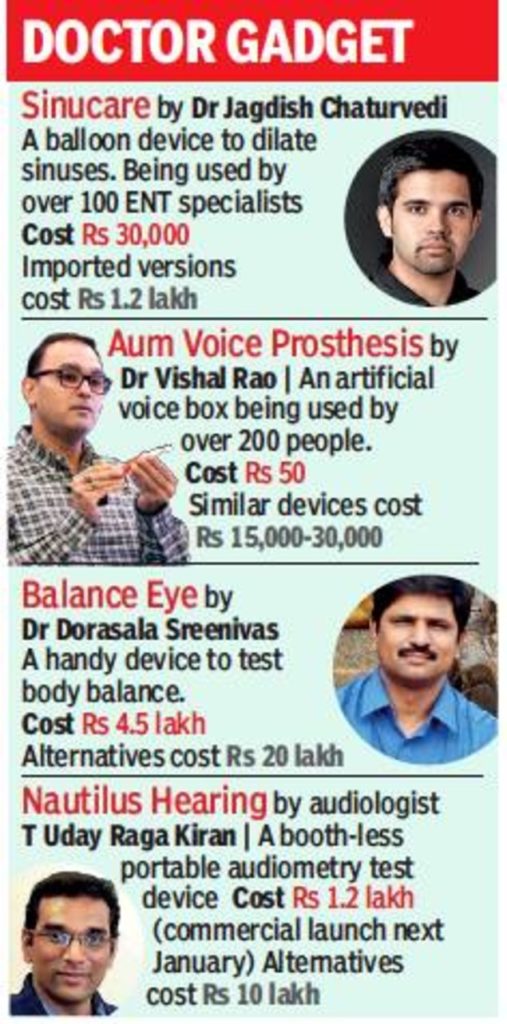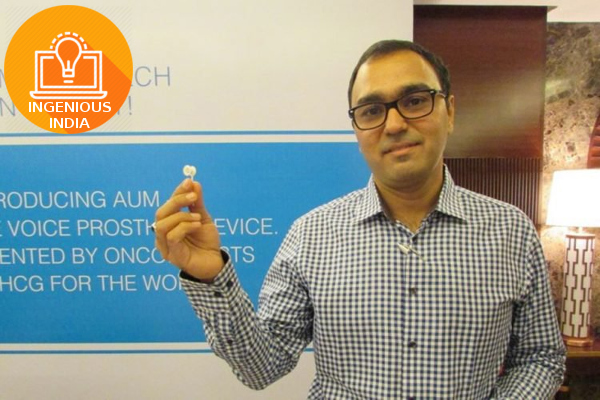Many young physicians are not content to stay locked in OTs and OPDs, they also tinker in labs to create affordable gadgets that make their patients’ lives easier
Stethoscope, heart monitor, pacemaker…Some of the world’s greatest medical inventions were the result of doctors who used design thinking to solve pressing medical problems. In India, too, doctors are innovating to make health-tech that’s more suited to local conditions, as well as more affordable.
Dr Vishal Rao, a cancer surgeon with HCG Hospital, Bengaluru, narrates a fascinating story of a patient from Bangladesh he treated a few weeks ago. This cancer patient had lost his voice after his larynx was removed. He was fitted with an artificial voice box, but it broke and he couldn’t seek a replacement due to the high cost involved. For eight long years, silence was his companion.

Dr Rao gave him the Aum Voice Prosthesis, an artificial voice box he designed and developed that cost just Rs 50. To test the silicone contraption powered by the patient’s lungs, Rao asked the patient to say a few words. The response was amusing: “Sheikh Hasina is already the prime minister; the Opposition got only three seats.” All the pent up political angst of eight years finally found a vent.
The existing devices, mostly imported, cost between Rs 15,000 and Rs 30,000 — pretty much beyond what most throat cancer survivors can afford. But Rao’s fix makes it available to all. The 40-year-old isn’t alone in his passion for innovation.
Dr Jagdish Chaturvedi was a student at St John’s Medical College, Bengaluru, in 2009 and was frustrated by the lack of of large monitors to see the results of an endoscopy in rural health centres. “We used long mirrors and headlamps to detect cancer lesions. I used to struggle a lot as I couldn’t always spot lesions on time, it was guess-work treatment,” says Chaturvedi who went to his senior, Dr Ravi Nayar, with the problem. “Dr Nayar told me to do something about it rather than just talk,” recalls Chaturvedi.
He purchased a digital camera, costing Rs 10,000 at the time, and got an engineer to attach an endoscope to it. Armed with this self-made portable recording device, he could see the insides of the throat clearly on the camera screen. He tried it out on patients and it worked. The device (patent pending) was commercially launched in 2013, and over 2 lakh patients have been screened so far using it.
Chaturvedi went on to invent 18 other devices, one of which was an extractor of foreign bodies from the nose. Children often shove coins, pebbles and erasers up their nose. “Around 38 million children need nasal foreign body removal in India every year. Parents usually take them to paediatricians but they are not trained in using a removal device. It can be used only by ENT specialists. And in rural areas, it’s hard to find an ENT doctor. So, we developed a low-skill extractor that can easily be used by general practitioners and paediatricians. It’s in pre-commercialisation stage at present,” says Chaturvedi, who specialises in sinusitis and practises thrice a week at his clinic in Bengaluru and spends the rest of the time innovating at his company, Hiiih Innovations Pvt Ltd.
So, how do these doctors who are often hard-pressed for time, get time to test and tinker? Many usually leave full-time practice and set up medical tech labs and hire designers, engineers and marketing professionals. Others cut down on their OPD hours. “A lot of doctors invent devices and publish results in medical journals. But people outside the community rarely get to know,” says Dr Nayar who is also the dean of academics at HCG Hospital.
Rao, though, thinks differently. “If someone gives me a big chamber to sit in and innovate, I won’t be able to. I need to see patients,” says Rao who has patents for a drone-bot and for theory of onco-theology. He has filed for patents for another 14 devices.
However, Dr Sreenivas Dorasala left full-time practice in 2015 to work on an affordable and ergonomic body balance testing device. The existing alternatives were costly, at Rs 20 lakh, and hence not available with many doctors.The 43-year-old developed Balance Eye and launched it in 2017. Priced at Rs 4.5 lakh, it is lighter, more compact and easy to handle. Already, over 120 are in use nationally. “There was a pressing need for an alternative. Somebody had to do it, so why not me,” asks Dorasala.
Source: ToI
Image Courtesy:LI
You may also like
-
New Heat-Based Approach To Cancer Treatment Can Reduce Chemotherapy Doses
-
Scientists Take A Major Step Towards Unification Of Classical & Quantum Gravity
-
India Graphene Engineering and Innovation Centre (IGEIC) Under the Vision of Viksit Bharat@2047 Launched
-
New High-Performance Gas Sensor can Monitor Low Level Nitrogen Oxides Pollution
-
Antidepressant Drug can be Repurposed for Treating Breast Cancer
